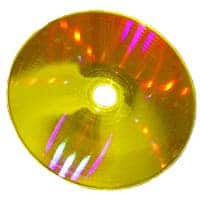Vynil, cassettes, all that, they were a long time ago; nowadays, blu-ray disks rule ! But it seems we’ve been using them for quite a while, so one can only wonder what’s the next step in optical disk technology ? Well, the next step is called HVD, which stands for Holographic Versatile Disk, which employs a technology called collinear holography.

In collinear holography, a green and a red laser are collimated into a single beam; the green laser data encoded as laser interference fringes from a holographic layer near the top of the disc, while the red laser serves as a reference beam and reads the servo invo from the aluminum layer, pretty much like in normal CDs.
The laser beams pass selectively through the layers due to a layer of dichroic mirrors that exists between the holographic and servo data layer. The HVD will be able to hold about 20-200 times more information than a blu-ray disk, and a transfer rate of 128 MB/second.
However, they are incompatible with current technology, and probably won’t appear for another 5-10 years; most plans are for implementing them in 2019 or 2010. However, it’s always good to know what the future holds for you… especially when it holds so much.
Was this helpful?